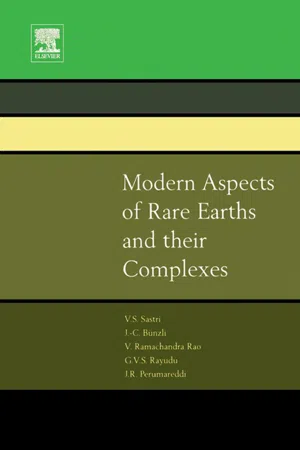Chemistry
Stability Constant
The stability constant in chemistry refers to the equilibrium constant for the formation of a complex between a metal ion and a ligand. It quantifies the stability of the complex, with higher stability constants indicating a more stable complex. The stability constant is a measure of the extent to which the complex is formed and remains intact under specific conditions.
Written by Perlego with AI-assistance
Related key terms
Related key terms
1 of 4
Related key terms
1 of 3
4 Key excerpts on "Stability Constant"
- eBook - ePub
- Geoffrey A. Lawrance(Author)
- 2013(Publication Date)
- Wiley(Publisher)
K values under non-ideal (in a thermodynamic sense) conditions, the term ‘constant’ here is not absolutely correct, as discussed above. Remember that it is defined only under the particular experimental conditions employed in reality, although it is fairly true to say that the value varies in only a limited way across the range of conditions that we are most likely to apply.There is also a direct relationship between the Stability Constant and the free energy (ΔG 0 , in kJ mol−1 ) of a reaction, expressed in terms of the relationship (5.6):(5.6)where R is the gas constant and T the temperature in Kelvin. This means that the higher is K , the more negative is the free energy of the reaction. We feel this usually as a release of heat on complexation, because of the relationship between free energy and reaction enthalpy (ΔH 0 ) and reaction entropy (ΔS 0 ), namely (5.7):(5.7)Examination of Equation (5.5) shows that a large value of K means a high concentration of MLn+ relative to Mn+ and L; in other words, a large K means a strong preference for complex formation. The size of K with metal complexes is usually so large that we tend to report log10 K values, for ease of use; obviously, it’s simply easier to refer to a (log) K of 7.5 rather than a K of 3.16 × 107 .In this discussion, we shall also meet another closely related type of Stability Constant, the overall Stability Constant (β), which represents the stability for a set of sequential complexation steps, rather than for an individual component step. It allows us to represent, for example, the Stability Constant for an overall reaction M + n L forming MLn , rather than just for a single ligand addition step such as M + L forming ML. As for K - Vinny R. Sastri, J.R. Perumareddi, V. Ramachandra Rao, G.V.S. Rayudu, J.-C. G. Bünzli(Authors)
- 2003(Publication Date)
- Elsevier Science(Publisher)
chapter 3STABILITY OF COMPLEXES
CONTENTS1 Methods2 Stability of rare earth complexes in solution3 Thermodynamic considerations4 Stability of macrocyclic complexes5 Double–double effect6 ApplicationsReferencesAppendixStability Constants of complexes may be determined by: (i) kinetic and (ii) equilibrium methods. In the present discussion, attention will be focused on mononuclear complexes and the fact that the activity coefficients of all the species can be held effectively constant by using suitable ionic media. The kinetic approach is applicable when: (i) the rates of formation and dissociation of a complex are sufficiently slow and (ii) accessible to experimental measurement by suitable techniques. Using the law of mass equationthe above gives the Stability Constant provided: (i) there is only one species in solution and (ii) there is only one rate-determining step involved. The ratio of forward and reverse reaction rate constants of a general nature may be written as [1 ]and similarly we may writeThe kinetic approach is of restricted utility because it is applicable to: (i) slow reactions, (ii) some transition metal ions, (iii) the role played by the electronic structure of the central metal ion. The equilibrium approach is more convenient than the kinetic approach and hence discussed here in a detailed manner. In general when a metal M complexes with a ligand A and forms complexes of the type MA, MA1 … MAN we may write for the total concentrations of M and A as(3.1)(3.2)provided mononuclear complexes are formed and the terms ‘m ’ and ‘a ’ represent the free concentrations of metal ion and ligand, respectively.When the system is inert or made inert, the equilibrium concentrations of some or all the species in solution can be determined analytically and hence the Stability Constants evaluated. In labile systems, free concentrations of metal ions may be determined by potentiometry or polarography and hydrogen ions and many anions by potentiometry. When there is a distinct difference in colors of the solutions, such as complexes with chromophores, UV-vis spectroscopy may be used in the determination of the equilibrium concentration of one of the species. Competitive reaction technique may also be used to determine free concentrations of metal (m ) and ligand (a ). Knowledge of the values of ‘m ’ and ‘a- eBook - ePub
- Detlev Möller(Author)
- 2015(Publication Date)
- De Gruyter(Publisher)
2 +. However, when adding more cyanide, AgCN is again dissolved:Transition metals such as Fe, Mn, and Cu are soil components and play an important role in redox reactions. Its solubility depends on pH (hydroxo complexes) and the concentration of available ligands. The equilibrium constants for complex ions must be known to describe the chemical status because different ferrato complexes also have different specific reaction rates in redox processes.3.2.3 Dynamic equilibrium and steady state
In environmental literature, the term equilibrium is often used to describe a situation of no changing amount of a substance in a reservoir in terms of dn /dt = 0 or F + = F − , orin otherwordsthat the forward and backward fluxes (or inflow and outflow) of a process are equal. However, this is not a chemical but a dynamic equilibrium and better to be named steady state .As noted before, one of the general conditions for chemical equilibrium is μ + = μ − . Although a chemical equilibrium occurs when two or more reversible processes occur at the same rate, and such a system can be said to be in steady state, a system that is in steady state might not necessarily be in a state of equilibrium, because some of the processes involved are not reversible. A system in a steady state has numerous properties that do not change over time. The concept of steady state has relevance in many fields, in particular thermodynamics. Hence, steady state is a more general situation than dynamic equilibrium. If a system is in steady state, then the recently observed behaviour of the system will continue into the future. In stochastic systems, the probabilities that various different states will be repeated will remain constant. We will generalise it as follows:A global biogeochemical cycle may be derived from the budget of composition of the individual reservoirs, with a (quasi) steady state being considered to exist. The substances undergoing the biogeochemical cycle pass through several reservoirs (atmosphere, hydrosphere, pedosphere, lithosphere and biosphere) where certain concentrations accumulate because of flux rates, determined by transport and reaction. - eBook - ePub
- Clyde Frank(Author)
- 2012(Publication Date)
- Academic Press(Publisher)
Nature of the metal ion. The metal ion influences the type of binding between the ligand donor atom and the metal ion. The more the bonds tend toward electrostatic bonds, the more stable is the complex.KINETICS
The magnitude of the Stability Constant does not reveal how the system reaches equilibrium or how long it takes for equilibrium to be reached. Only after elucidating the kinetics of the reaction is it possible to discuss quantitatively these two important aspects of the complexation reaction.The complexation reaction can involve a series of complicated steps and the time for the reaction to take place can vary over a wide range. For example, reaction (15-4) is virtually completed in the time it takes to mix the solutions, while reaction (15-5) is very slow.(15-4)(15-5)To describe this type of rate behavior the terms inert and labile were suggested. The complex, [Cu(NH3 )4 ]2+ , would be described as a labile complex while [Co(NH3 )6 ]3+ would be an inert complex. By definition a labile complex is one which undergoes a reaction in the time of mixing, assuming the experimental environment is at approximately “normal” conditions (mixing time of 1 minute, room temperature, and 0.1 F solutions). An inert complex participates in reactions that are too slow to be measured or proceed at rates which can be followed by conventional methods, again assuming “normal” reaction conditions. The terms, inert and labile, should not be confused with the stability of the complex. There is no relationship between the Stability Constant for the formation of the complex and the complexes designation as being either labile or inert.ADVANTAGES AND PRACTICAL ASPECTS OF COORDINATION COMPOUNDS
Coordination compounds possess a variety of physical and chemical properties which are very useful to the analytical chemist. Several of the more significant ones are cited below.Production of a Characteristic Color
Formation of a colored coordination compound can provide evidence of the presence of a metal ion or anion. For example, if a drop of a neutral Cu2+ solution is placed on a piece of filter paper, held over ammonia vapors, and treated with a drop of 1% alcoholic solution of dithiooxamide (rubeanic acid), I , a black or green coloration due to the formation of the polymeric coordination compound II
Index pages curate the most relevant extracts from our library of academic textbooks. They’ve been created using an in-house natural language model (NLM), each adding context and meaning to key research topics.
Explore more topic indexes
Explore more topic indexes
1 of 6
Explore more topic indexes
1 of 4



